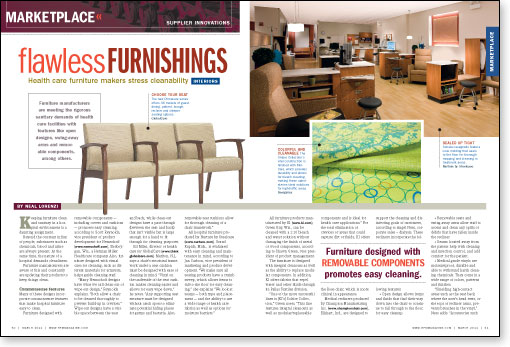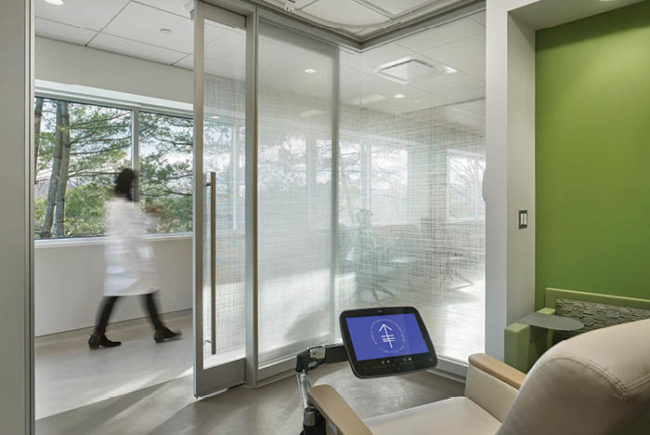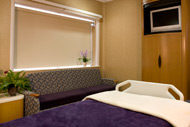
Keeping furniture clean and sanitary in a hospital environment is a daunting assignment.
Beyond the constant influx of people, substances such as chemicals, blood and urine are always present. At the same time, the nature of a hospital demands cleanliness.
Furniture manufacturers are aware of this and constantly are updating their products to keep things clean.
Commonsense features
Many of these designs incorporate commonsense features that make hospital furniture easy to clean.
Furniture designed with removable components — including covers and cushions — promotes easy cleaning, according to Scott Reynolds, vice president of product development for Nemschoff (www.nemschoff.com), Sheboygan, Wis., a Herman Miller Healthcare company. Also, furniture designed with visual cues for cleaning, such as different materials for armrests, helps guide cleaning staff.
"Many Nemschoff designs have what we call clean-out or wipe-out design," Reynolds explains. "Both allow a chair to be cleaned thoroughly to prevent build-up in crevices." Wipe-out designs have a visible space between the seat and back, while clean-out designs have a pass through (between the seat and back) that isn't visible but is large enough for a hand to fit through for cleaning purposes.
Ed Miles, director of health care for GlobalCare (www.thinkglobalcare.com), Marlton, N.J., says a chair's structural framework under a seat cushion must be designed with ease of cleaning in mind. "Vinyl on the underside of the seat cushion makes cleaning easier and allows for easy wipe down," he notes. "Any supporting seat structure must be designed without catch spots to eliminate potential hiding places for germs and bacteria. Also, removable seat cushions allow for thorough cleaning of a chair framework."
All hospital furniture produced by Nurture by Steelcase (www.nurture.com), Grand Rapids, Mich., is evaluated with easy cleaning and maintenance in mind, according to Jan Carlson, vice president of marketing and product development. "We make sure all seating products have a crumb sweep, which allows items to fall to the floor for easy cleaning," she explains "We look at seams — both type and placement — and the ability to use a wide range of health care fabrics as well as options for moisture barriers."
All furniture products manufactured by KI (www.ki.com), Green Bay, Wis., can be cleaned with a 1:10 bleach and water solution without damaging the finish of metal or wood components, according to Shawn Green, vice president of product management.
The furniture is designed with integral cleanouts as well as the ability to replace modular components. In addition, KI offers fabrics that repel water and other fluids through its Pallas Textiles division.
"One of the more successful lines is [KI's] Soltice Collection," Green notes. "This line features integral cleanouts as well as modular/replaceable components and is ideal for health care applications." For the total elimination of crevices or areas that could capture dirt or fluids, KI offers the Rose chair, which is more clinical in appearance.
Medical recliners produced by Champion Manufacturing Inc. (www.championchair.com), Elkhart, Ind., are designed to support the cleaning and disinfecting goals of customers, according to Angel Ness, corporate sales - dialysis. These recliners incorporate the following features:
- Open design allows items and fluids that find their way down into the chair to continue to fall through to the floor, for easy cleanup.
- Removable seats and swing-away arms allow staff to access and clean any spills or debris that have fallen inside the recliner.
- Seams located away from the patient help with cleaning and infection control, and add comfort for the patient.
- Medical-grade vinyls are moistureproof, durable and able to withstand harsh cleaning chemicals. They come in a wide range of colors, patterns and finishes.
"Shielding high-contact areas such as the seat back where the user's head rests, or the tops of recliner arms, prevents breaches in the vinyl," Ness adds. "Accessories such as arm covers and a protective head flap for the seat back protect and lengthen the life of vinyl in these areas."
Furniture from Kwalu (www.kwalu.com), Atlanta, also has a clean-out feature that allows for easy debris removal as well as removable cushions that facilitate deeper cleaning. In addition, furniture components are made with an antimicrobial finish that withstands everyday-cleaning solutions, including bleach.
"We have relationships with fabric manufacturers, so clients can partner our long-lasting and durable finish with easy-to-clean fabrics," says Chad Langville, director of business development. "When it comes to casegoods, [our] collections have feet and are raised off the floor, which facilitates cleaning under the unit."
Casegoods manufactured by Northland Furniture Co. (www.northlandfurniture.com), Bend, Ore., feature plastic laminate tops on all horizontal surfaces, according to Joey Drucker, corporate marketing and project manager.
Special attention is paid to covering the seam where the wood edge is attached, which allows housekeeping staff to clean without exposing joints to cleaning solvents.
"The use of melamine on vertical surfaces creates a completely 'wipe-able' product," Drucker adds. "In addition, the sealing of all exposed surfaces underneath the case prevents it from absorbing moisture from the floor after cleaning."
Clinical environment
Hospital infusion areas require special furniture designs because of the damage the chemicals can cause. Experts agree that in these areas, products must feature durable surface materials designed to accommodate hospital cleaning protocols.
When carts are used in clinical areas, all interior components should be removable so that every surface — inside and out — is accessible for cleaning. Removable fabrics and cleanouts make items easy to clean in emergency waiting rooms as well as in treatment areas where spills are common.
Nurture by Steelcase offers solid-surface tops as a standard option to promote cleanability in infusion areas. "This ensures there are no edges that could be exposed to moisture and germs," says Carlson. "We offer drawer liners as an option for easy cleaning. We also offer modular products that seal to the floor with cove molding for use in clinical areas."
Blood and urine resistance. Treatment areas, patient rooms and emergency departments are the places most likely to experience exposure to blood and urine. Which furniture fabrics are resistant to them? "Nemschoff offers vinyl, non-PVC and a composite film product that prevent blood and urine from permanently damaging the fabrics," says Reynolds. Durawrap, a material used on Herman Miller Healthcare's Compass system, is durable, easy to clean and resistant to blood and urine.
For effective blood/urine resistance, the best types of upholstery incorporate non-porous, coated materials, according to Marty Gurian, director of engineering, Designtex, a subsidiary of Steelcase that provides textiles for Nurture products.
"Our Extreme Performance vinyl or polyurethane upholsteries have built-in fluid barriers, protective coatings and finishes, antimicrobial additives and can be bleach treated as well as disinfected with a wide range of germicides and disinfectants," he explains.
Cleaning-damage resistance. Which fabrics stand up to repeated cleanings with harsh chemicals? Which patterns and colors? Which types of wood trim? Specialized products are available to meet these needs as well. However, experts agree that housekeeping staff must use the right cleaning agents in the proper proportions. Also, using cleaners that are not approved or recommended can damage furniture finishes and textiles.
The types of fabrics that traditionally stand up best to harsh and repeated cleanings are vinyl, non-PVC and solution-dyed, according to Reynolds. All allow a bleach solution to be used for cleaning. Of course, any fabric runs the risk of not maintaining its look if it isn't cleaned according to the manufacturer's standards, he adds.
Many factors determine whether an upholstery type is appropriate for repeated treatment with specific cleaning agents and disinfectants, according to Gurian of Designtex.
"Patterned designs with color usually show fewer stains and require less frequent care than do solid, light colors," he notes. "Nonporous or tightly woven, flat fabrics constructed from snag- and pill-resistant yarns (protected with a finish or coating) are the most serviceable.
"As texture, pile and looseness of a textile's weave increases," Gurian says, "it is more challenging to clean and disinfect because microorganisms can penetrate into the upholstery and assembly."
Wood that is coated with a durable lacquer can withstand cleaning disinfectants, according to Northland's Drucker.
"Catalyzed varnish topcoats on wood help resist chemical abrasion," she explains, "and manufacturers of catalyzed varnishes routinely test for abrasion, scratch and chemical resistance." A responsible manufacturer designing furniture for this market most likely will research the most reliable source, she adds.
From a consultant's perspective, Barbara Huelat, interior design principal with Huelat Parimucha Ltd., Alexandria, Va., says housekeeping staff should avoid using harsh chemicals for cleaning because they can be toxic to patients. This is especially critical in infusion areas.
She suggests that hospitals work with maintenance staff and manufacturers to find the best solution. One suggestion: Get a sample chair or other piece of furniture and let environmental services (ES) see how in-house cleaning staff work with the new piece.
Keeping staff informed
What is the best way to train ES or housekeeping staff to properly clean furniture? Experts agree that keeping housekeeping staff in the loop is important, as are obtaining and using feedback from suppliers. Also, it is important to make use of product manuals that list cleaning instructions.
"Written guidelines should be available for hospital staff or outsourced cleaning personnel to follow regarding the disassembly and reassembly of cleanable components," advises Miles of GlobalCare.
ES personnel should provide specific cleaning requirements to housekeeping staff, he adds, and vendors should be provided with information about the cleaning chemicals the hospital intends to use prior to acquiring new furniture. "This will eliminate issues after the product is put in service."
Huelat agrees that ES and housekeeping should be involved in the selection process. Their input is valuable because they see what works and what does not. However, their recommendations must be balanced against clinical and user needs.
Gurian of Designtex says housekeeping staff must be made aware of the upholstery types located in a space and the recommended cleaning and disinfection procedures required. Also, he urges that purchasing departments and specifiers make their suppliers aware of the particular cleaning and disinfection protocol required in various hospital areas.
Many factors
Many factors are involved in ensuring that hospital furniture stays clean and attractive, even under duress.
Ness of Champion offers this advice to meet the challenge: Ensuring optimal cleaning is a multipronged process.
Quality components, education, customer support and thoughtful design are the best combination of elements to support effective cleaning and maintenance of hospital furniture.
Neal Lorenzi is a freelance writer based in Mundelein, Ill.
| Sidebar - For more information |
| To learn more about the furnishings discussed in this month's "Marketplace," readers can contact the following manufacturers. »Champion Manufacturing »GlobalCare »Herman Miller Healthcare »KI »Kwalu »Nemschoff »Northland Furniture Co. »Nurture by Steelcase |





